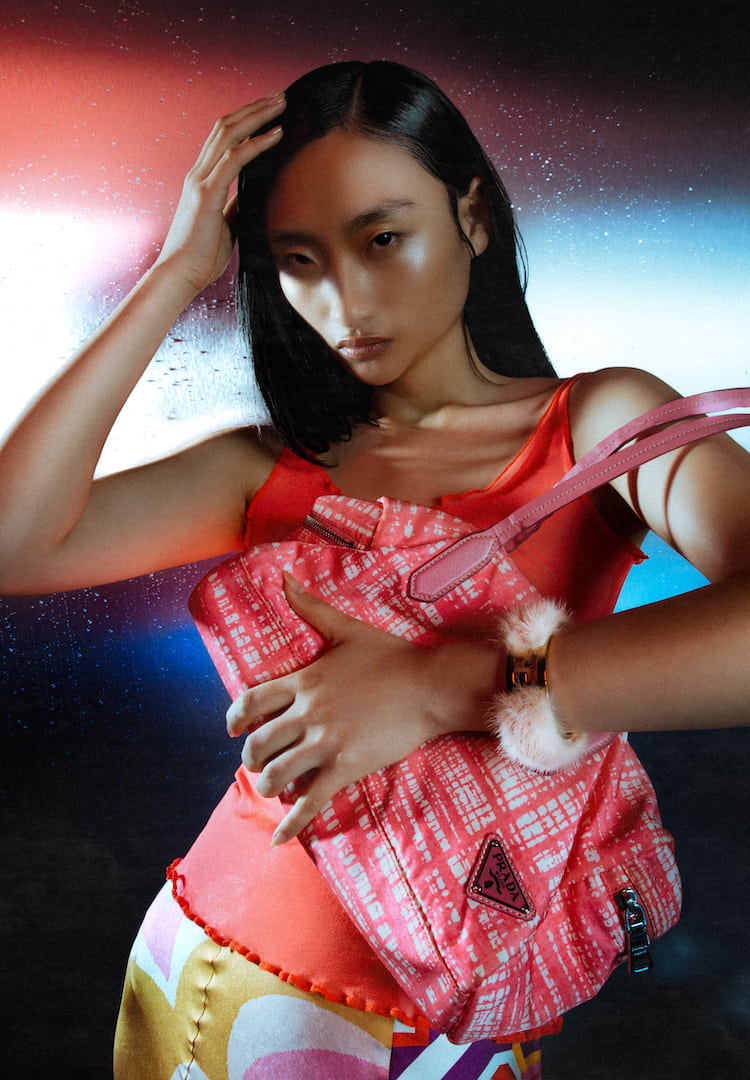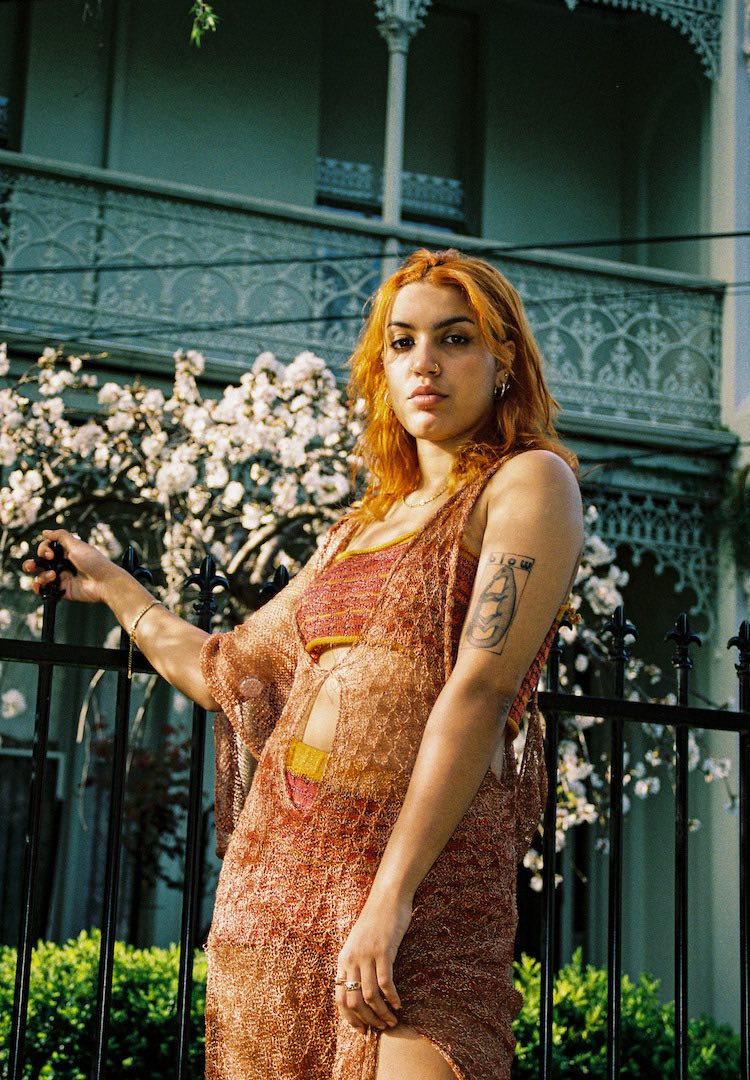Melbourne label Hey Zoe May creates zero-waste, locally-made, made-to-order knitwear
PHOTOGRAPY BY Kyah zois
WORDS BY MAGGIE ZHOU
“The kind of pieces you reach for when you’re happy, cheer you up when you’re sad, and you’ll treasure for years to come.”
Mindful practices can be found all around us – there are colouring books for adults, forest bathing rituals and breathing techniques. That’s all to say the act of mindfulness can look different to everyone. For Brunswick-based and New South Wales-born creative Zoe May Sutherland, knitting is her escape. It’s become a form of therapy for her; a way to express her feelings without having to say a word.
For more fashion news, shoots, articles and features, head to our Fashion section.
Her label Hey Zoe May is the natural result of her love of knitwear. Given the medium, every piece is unique, made-to-order and currently available in sizes four to 20. From her days selling pieces on Etsy after graduating high school to now, fashioning micro skirts and bike shorts out of yarn, Zoe has created something special. Below, hear more about her label and the journey she’s been on.
Tell us about you. What’s your fashion background?
I grew up in regional NSW and have been knitting and crocheting since [I was] about 10 years old. After high school, I studied journalism and sold handknitted accessories on Etsy and in one of the few stores in town. Like most knitters on Etsy back then, I charged way too little for my time, but I learned a lot!
I moved to Melbourne in 2017 to study fashion design at RMIT, where I took a knitting machine elective and fell in love. I then specialised in knitwear in my final year. These days I work as a production coordinator for another local brand (shoutout to Dominique Healy for being the most supportive boss and mentor) while working on Hey Zoe May every other spare moment!
View this post on Instagram
How did the label get started? Talk us through the process and the challenges.
Hey Zoe May kind of started with my final year collection at RMIT. My cohort spent the year in and out of lockdowns with restricted access to campus. I found my precious mint green vintage Empisal knitting machine on eBay which meant I could work from home. My graduate collection started as a development of knit techniques for deadstock yarns and scraps normally too small for use in production.
Close to the end of the year, my family experienced a devastating loss and I considered leaving the course. A therapist suggested I ‘colour in’ my feelings rather than explain them in words. I realised that’s what I was already doing through my knitting. In a way, that’s what we’re all doing when we choose what to wear each day.
View this post on Instagram
The changing colours and rhythmic feeling of the knitting machine became a kind of therapy for me. I drove my housemate crazy knitting into the night, making a giant colourful cord which I then handknitted into a huge jacket (and secretly, a huge journal of feelings).
I took some time to work and save after graduating, and when it felt like the right time, I started releasing a few of the smaller pieces from my collection. It’s still early days, but my biggest challenge so far has honestly been battling my own mind! I struggle a little with body dysmorphia, which is a pain when it comes to sharing myself on social media… It feels like a silly challenge to mention, but I’m always so surprised and comforted when other people talk about this topic, so hopefully someone out there will feel the same way here.
View this post on Instagram
What were you trying to achieve from the project at the time?
Long story short, I wanted to make clothes that are as environmentally neutral as possible, [and] make you feel something when you wear them. The kind of piece that physically and emotionally brightens your rainy day and feels like a treasure.
I’m a big admirer of the Fibershed Movement, a term coined by Rebecca Burgess in 2011, describing the geographic region from which all the resources come [from] to make an article of clothing. Rebecca handcrafted a capsule wardrobe using fibres grown, milled and dyed all within her region. It’s a beautiful story and movement and something I’m always aspiring toward as a maker and a label.
View this post on Instagram
How has this evolved and what are you trying to communicate through the brand now?
I have so many plans and goals for the rest of this year. Size inclusivity is something I really want to focus on. Being a made-to-order label means I can offer a full-size range (currently sizes four to 20) right away. I’d also like to explore other natural fibres in future pieces.
How would you describe your brand to someone who’s never seen it before?
Zero-waste, locally-made knitwear in saturated colours and luxurious textures. The kind of pieces you reach for when you’re happy, cheer you up when you’re sad, and you’ll treasure for years to come.
View this post on Instagram
What are you most proud of in your work on your brand?
The winter collection I’ve just released is a huge moment [for me]. I’m proud I’ve come this far, backed myself financially for this long and that I’m writing this article right now! It feels like I’m all in and there’s no turning back now.
What do you wish you had known when you started?
Slow and steady consistency really works. It’s so important to give yourself lots of little breaks rather than going all in for a month and then crashing for [another]. People usually aren’t thinking about you, meaning it’s not annoying to post regularly about your work. Lastly, try and save more money than you think you’ll need, but don’t let this hold you back forever!
View this post on Instagram
What is most exciting in the Australian and New Zealand fashion scene right now?
Maybe this is the country bumpkin in me talking, but there’s just so much going on since the lockdowns have ended. Retailers like Sucker in Melbourne and Bizarre Bazaar in New Zealand supporting indie brands, companies like Upparel, startup magazines and podcasts, [and] the amazing stylists and photographers starting out.
There’s a literal endless stream of creative opportunities and people looking to do work together. The slow fashion scene in particular is so kind. If you’re respectful and have your own vision, people are genuinely excited to help you and give advice. Everyone just wants to see each other succeed because one person can’t do it all. We’re all in it together and I love that!
View this post on Instagram
What about the Australian and New Zealand fashion scene needs to change?
This is a hard one to answer because I think anyone who works in fashion knows there’s a lot that needs to change. We can spend all day sitting around and talking about how terrible it is (in fact I do this pretty regularly with my coworkers), but this can create a bit of an echo chamber as we’re not really including anyone new into the conversation.
The most interesting debates I’ve seen lately have actually been on TikTok, where ethically-produced brands explain their higher prices to shoppers who know nothing about garment manufacturing. Like any social change, it’s about including more people in the conversation. Shopping ethically is still a financial privilege, but being paid a livable wage is a right. I suppose it’s up to those of us who [can] vote with our money to slowly push the needle for everyone else.
Take a closer look at Hey Zoe May’s made-to-order pieces here.













